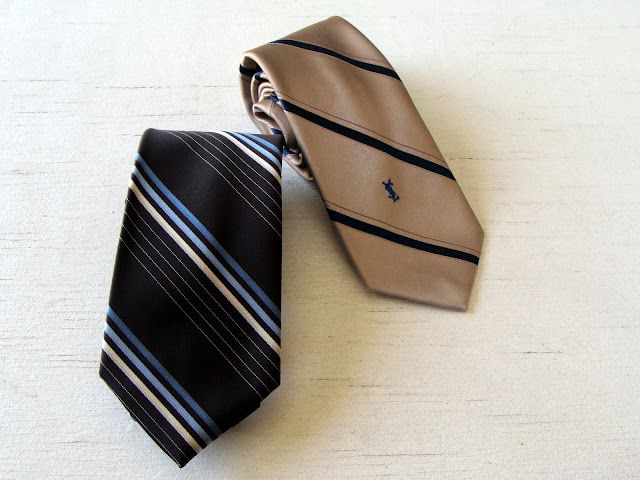For most of us vintage lovers, the show Mad Men has become our mid-century ideal, with the décor, incessant drinking and of course, the fashion. I am here to announce that I will be educating myself in vintage men’s wear, specifically ties. Hopefully in the future I would like to increase my knowledge to include hats (I personally love wearing hats), suits and other accoutrements that make the likes of Don Draper and Roger Sterling look so awesome. To go along with my newfound interest and knowledge, we have found almost 2 dozen vintage ties from the 50s, 60s and 70s. Skinny ties, wide ties, thin stripes, wide stripes, and plenty of colors to go around.
I was surprised to find that men’s fashion world is surprisingly small, so even though this might sound like a short history lesson, every name that I drop is represented in our current collection of ties. Christian Dior (you probably have heard of him) was a French designer that helped train and groom Yves Saint Laurent as his replacement during the 1940s and 50s. He also trained Pierre Cardin in the 1940s who went on to be one of the first ready-to-wear designers in France. He essentially made high fashion clothing more available.
Moving on to Italian designers, we have Angelo Correlli that designed in Italy with fancy smancy imported silks. Oleg Cassini came to America in the 30s, designed for Hollywood actresses and eventually became Jacqueline Kennedy’s one and only clothing designer. He also popularized men’s turtlenecks and colored dress shirts.
Don Loper was an American designer in Beverly Hills and was actually featured in an I Love Lucy episode as himself. His ties have a certain old Hollywood feel.
 I also want to mention a tie
manufacturer and a material manufacturer that I learned about in my
research. Wembley, named not after the
stadium in England where Queen recorded their live album, but the city where
that stadium is located, has been making ties in New Orleans since 1925 and is
still one of the world’s largest tie manufacturers. The material I found out about is called
Trevira, a 100% recyclable polyester.
First made in Germany in 1956, it was used in clothing into the 70s. It is still used today as a material in
industrial applications.
I also want to mention a tie
manufacturer and a material manufacturer that I learned about in my
research. Wembley, named not after the
stadium in England where Queen recorded their live album, but the city where
that stadium is located, has been making ties in New Orleans since 1925 and is
still one of the world’s largest tie manufacturers. The material I found out about is called
Trevira, a 100% recyclable polyester.
First made in Germany in 1956, it was used in clothing into the 70s. It is still used today as a material in
industrial applications. There are a few other names of retailers, labels and designers but I haven’t been able to find any information about them as of yet. When these ties are listed in the shop I hope to include at least a little bit of history on them.
I want to thank Burl Veneer’s TieBlog for some great information and being a springboard for other research, as well as his fabulous tie collection. Another great source of information was TheVintage Fashion Guild which I hope to join and contribute to as I learn more.
Finally, (since I don’t know when the wife is going to let me write another one of these) I want to talk a little about the other stuff I learned while learning about ties. The words dextra and sinistra (right and left) are Latin and were used to describe crests on shields. From what I understand, dexter and sinister, the modern versions of the words, are used to describe a diagonal stripe from the bearer or wearer’s point of view. A dexter to sinister stripe is one that would begin on the wearer’s right shoulder and extend to the left hip while a sinister to dexter pattern would be from the left shoulder to right hip. It is possible that the reason the sides are described in respect to the wearer is because the words were originally used for weapons training in ancient Rome. I like the idea that a technique for training Roman soldiers has made its way into the modern world to describe the orientation of a striped tie. And I bet you all thought ties were mundane!
For more from the manly side of The Sunshine Grove, visit J's Workbench!






Ties first appeared as part of men's fashion as early as the 1600s, and have been changing and evolving ever since. So how do you know which styles of ties are currently in fashion? Here are some tips on how to pick a stylish tie.
ReplyDeleteprom dresses cheap